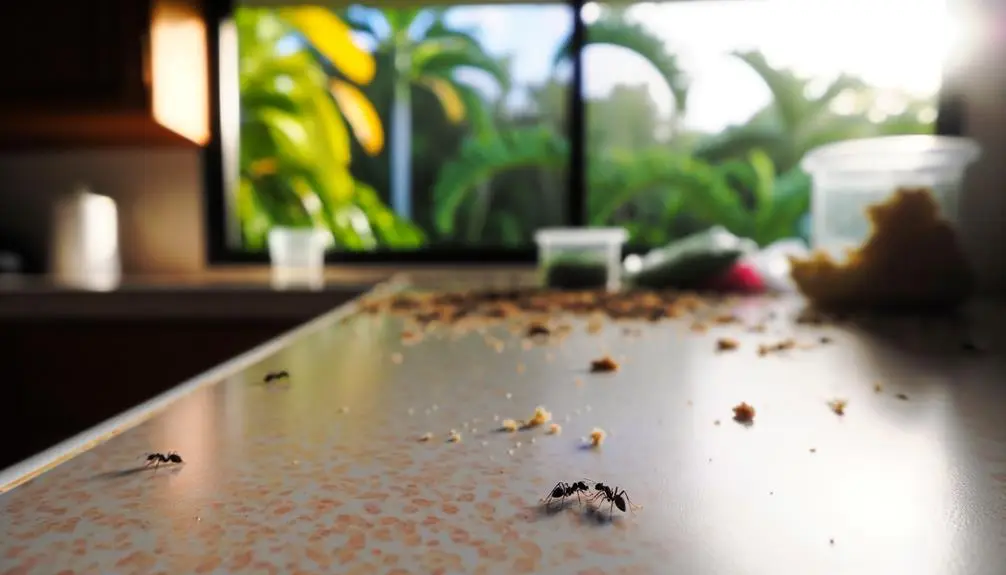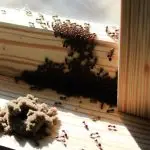In South Florida, common black ants in house like the crazy ant and white-footed ant are often found in homes. These species thrive in the warm, humid climate, drawn by accessible food sources. Crazy ants are known for their erratic movements and can quickly form large colonies, while white-footed ants prefer sweet substances, making kitchens a typical foraging ground. To manage these infestations, you should focus on cleanliness, sealing entry points, and using both non-chemical and chemical control strategies. Understanding their behaviors and nesting habits is vital in effectively addressing the issue, and there’s more to explore regarding prevention tactics.
Key Takeaways
- Crazy ants and white-footed ants are the most common black ant species found in South Florida homes.
- These ants are attracted to sweet substances and often invade kitchens and bathrooms.
- Ants can nest in various locations, including decaying wood and plant cavities near human dwellings.
- Effective pest management includes sealing entry points, eliminating food sources, and maintaining cleanliness.
- Infestations can disrupt daily life and may decrease property values due to health concerns.
Overview of Common Ant Species
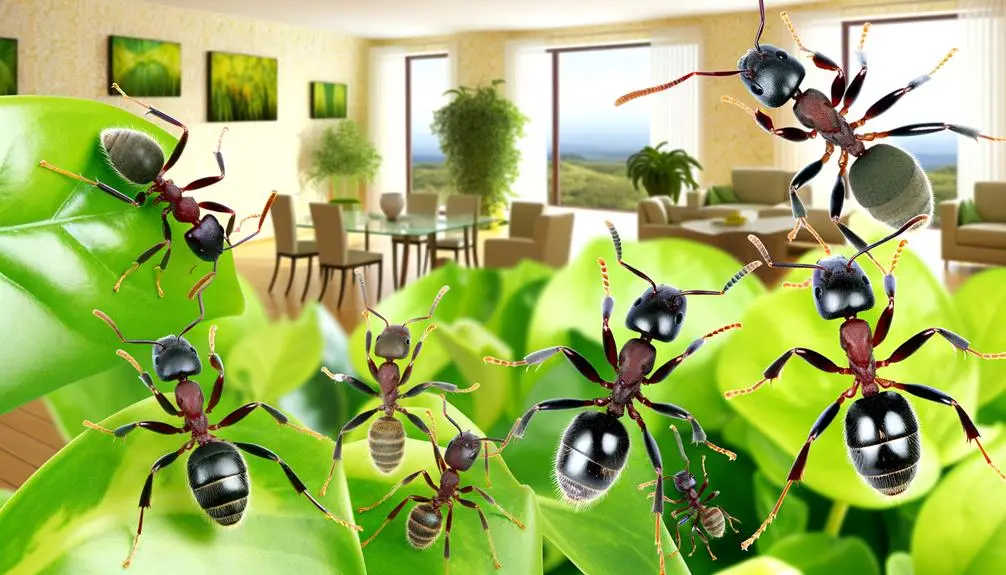
When you think of common ant species in South Florida, two notable examples come to mind: the Crazy ant (Paratrechina longicornis) and the White-footed ant (Technomyrmex difficilis). Both of these species have adapted remarkably well to the region’s subtropical climate, making them frequent visitors to homes and businesses. The Crazy ant is easily recognizable due to its erratic movements and tendency not to follow trails like other ants do. This behavior often makes them a nuisance in urban settings, where they can thrive in disturbed environments. Additionally, these ants can disrupt local ecosystems, highlighting the need for effective control methods for common ants.
In contrast, the White-footed ant, which was first identified in Florida in the late 1980s, has quickly become a significant pest. It’s particularly attracted to sweet substances, often found foraging in kitchens and bathrooms. Unlike some other ant species, the White-footed ant doesn’t bite or sting, but its presence can be bothersome due to its large colonies, which can number in the thousands.
Both species play important roles in the ecosystem, aiding in the dispersal of seeds and the management of other insect populations. However, they can also disrupt human activities, especially in agricultural settings. Understanding these common ant species is crucial for effective pest management strategies. By recognizing their behaviors and habitats, you can take preventative measures to minimize their impact in and around your home.
Identifying Black Ants
Identifying black ants can be straightforward if you know what to look for. First, observe their size. Most black ants measure between 2.5 to 15 millimeters long, depending on the species. Common varieties, like the little black ant, are particularly small, while carpenter ants can be significantly larger. For effective ant control services, it’s essential to recognize these pests early on to prevent infestations. Next, notice their color. True to their name, these ants typically exhibit a dark brown to black hue, sometimes with a slight sheen.
You’ll also want to examine their physical features. Black ants have elongated bodies, with a distinct waist that can vary by species. For example, carpenter ants possess a single node between their thorax and abdomen, while other species may show two. Their antennae are typically segmented, and you might observe a rounded or elongated head shape, which can aid in identification.
Another helpful tip is to pay attention to their movement. Black ants often move in a brisk, steady manner. They may forage alone or in groups, depending on the species and the food source’s location.
Crazy Ant Characteristics
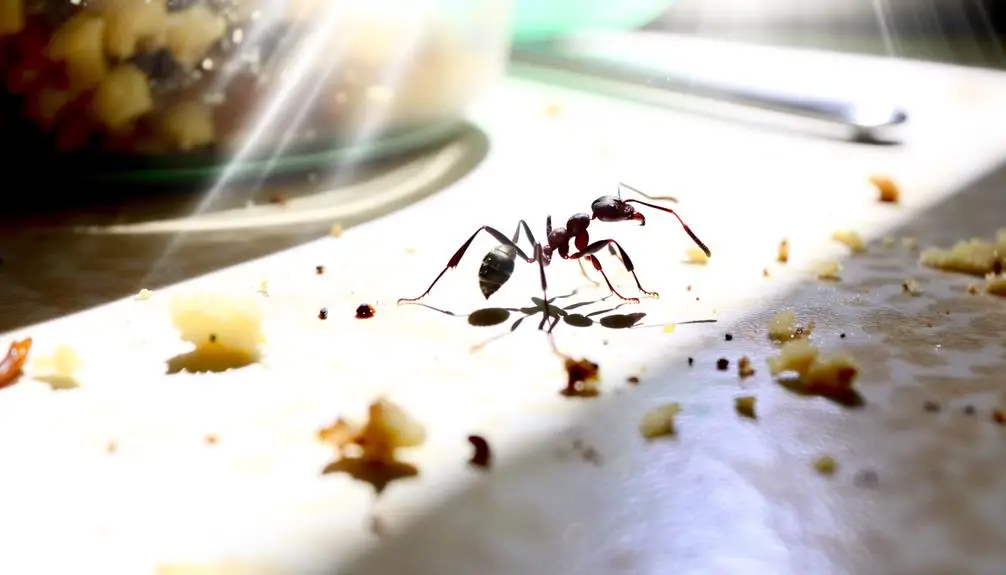
Crazy ants, known scientifically as Paratrechina longicornis, are easily recognized by their distinct erratic movements and lack of established foraging trails. These small ants typically measure between 2.3 and 3 mm in length and display a dark brown to blackish coloration, often with a bluish iridescence. Their long, 12-segmented antennae and elongated scapes set them apart from other ant species. You’ll notice they have a wedge-shaped petiole, which is slightly tilted forward, and while they lack a stinger, they can deliver a bite if provoked. Understanding pest behavior can aid in developing effective control measures.
One of the most fascinating traits of crazy ants is their foraging behavior. Unlike some ants that follow defined paths, crazy ants seem to wander erratically, which can make them more challenging to control. They’re omnivorous, feeding on a variety of substances, including live and dead insects, seeds, and honeydew produced by aphids and mealybugs. Their colonies can vary significantly in size, often comprising thousands to millions of individuals, and they thrive in disturbed environments.
These ants are highly adaptable, nesting in a range of locations from trash to plant cavities. They can be found in both dry and moist environments, making them a common nuisance in homes and warehouses. If you encounter crazy ants, understanding their characteristics can help you identify effective management strategies to keep them at bay.
White-Footed Ant Details
The white-footed ant, scientifically known as Technomyrmex difficilis, poses a unique challenge for homeowners in Florida. This ant species is particularly notorious for its foraging behavior, which often leads to infestations in kitchens and bathrooms. While these ants don’t bite or sting, their presence can be bothersome. Typically, colonies can range from 8,000 to 3 million individuals, making them a formidable nuisance.
To help you better understand the white-footed ant, here’s a concise overview of its characteristics and behavior:
| Characteristic | Details |
|---|---|
| Preferred Habitats | Vegetation like palms, fruit trees, and flowering plants |
| Foraging Behavior | Attracted to sweet substances and dead insects |
| Colony Size | Can vary between 8,000 to 3 million members |
Additionally, the white-footed ant is often associated with other pests, as it tends to protect honeydew-producing insects. Its ability to thrive in urban settings has made it a significant pest in Florida, leading homeowners to seek pest control solutions.
Management strategies for controlling this species primarily focus on baiting, which has proven effective in reducing populations. Keeping your environment clean and free of food sources will also help deter these ants from entering your home. Understanding their behavior and habitat preferences is crucial for effective prevention and control. By being proactive, you can minimize the impact of white-footed ants in your living space.
Acrobat Ant Features
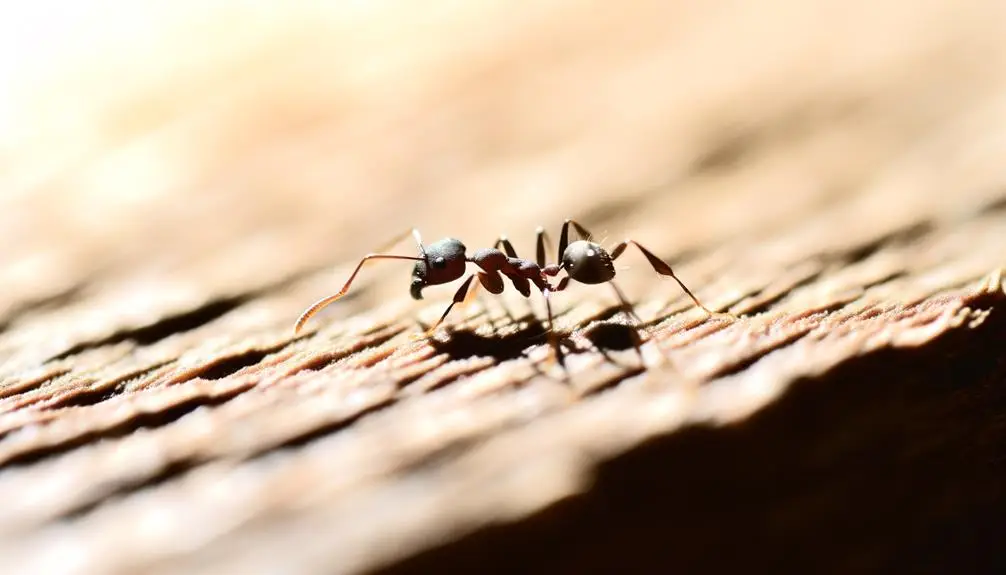
Among the diverse ant species in Florida, the acrobat ant, scientifically known as Crematogaster ashmeadi, stands out due to its distinctive features and behaviors. One of the most notable characteristics of acrobat ants is their unique body shape. Their gaster, or abdomen, often arches upward, giving them a distinctive appearance that resembles an acrobat balancing on a tightrope. This unique posture is not just for show; it aids in their defense mechanism, allowing them to present a more intimidating profile to potential threats. In South Florida, where pest control is essential for maintaining a comfortable living environment, understanding these pests is crucial for effective management and prevention, especially through natural and organic methods.
You’ll find acrobat ants typically range in color from light brown to black, with a glossy appearance. They are relatively small, measuring about 2.5 to 5 mm in length. Their antennae are 12-segmented and lack a distinct club, which is a feature that helps differentiate them from other ant species. Acrobat ants also possess a single node between the thorax and gaster, making them easier to identify.
Their foraging behavior is quite agile, and they often scavenge for honeydew, insects, and plant materials. Acrobat ants are known to form large colonies, which can contain thousands of individuals, enhancing their ability to adapt to various environments. You might notice them foraging both indoors and outdoors, especially in areas with abundant food sources. Overall, the acrobat ant’s distinct morphology and behavior make it an intriguing species to observe in the ecosystems of South Florida.
Nesting Habits of Ants
Understanding the nesting habits of various ant species is essential for effective pest management in South Florida. Ants can adapt to numerous environments, making their nesting behaviors quite diverse. Many species prefer to nest in areas that provide protection and moisture, often choosing locations like under rocks, in decaying wood, or within plant cavities. Some common black ants, such as the crazy ant or the acrobat ant, often establish their colonies in disturbed areas, which can include your backyard or even inside your home. Utilizing eco-friendly methods is a vital part of managing these pests while ensuring safety for the environment.
Ant colonies can vary significantly in size, from just a few dozen individuals to millions, depending on the species. When you observe ants carrying food, it often indicates their nest is nearby. Interestingly, some species will nest away from their foraging areas to avoid detection, which can complicate control efforts.
Nesting can occur year-round in warmer climates like Florida, allowing colonies to thrive without seasonal limitations. You might notice nests in moist environments, as they provide the necessary conditions for brood development. If you’re dealing with an ant infestation, look for signs such as frass or large numbers of workers; these can help identify nesting locations.
To manage ant populations effectively, consider sealing entry points around your home and eliminating food sources that attract them. By understanding where these ants choose to nest, you can take proactive steps to prevent and control infestations in your living space.
Foraging Behavior Insights
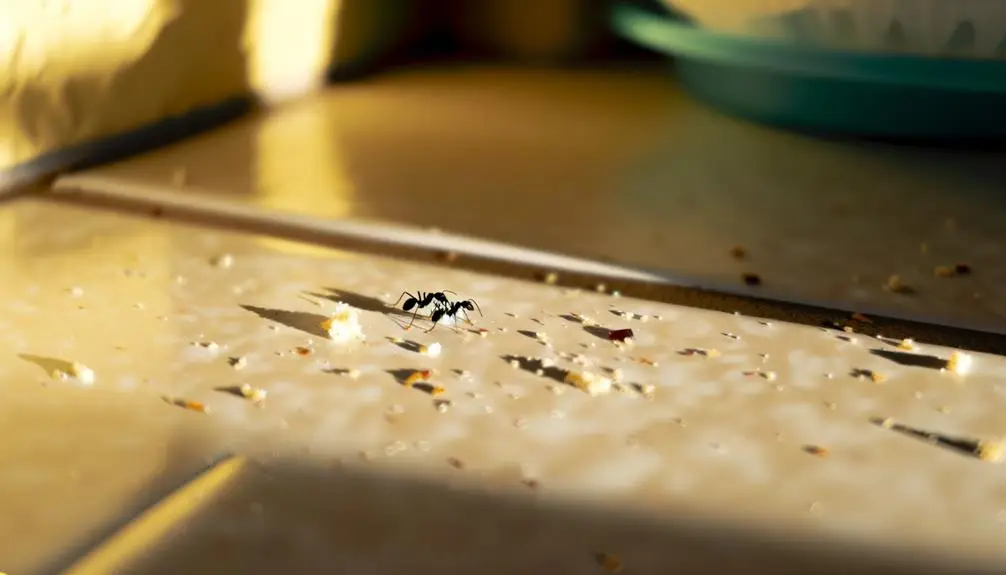
Observing ants in action can reveal much about their foraging behavior, which plays a key role in their survival and adaptability. You might notice that common black ants, like crazy ants, exhibit distinct foraging patterns that help them locate food efficiently. Their foraging strategy is primarily omnivorous, meaning they’ll consume a wide variety of substances, including live and dead insects, seeds, honeydew, and fruits.
During certain seasons, particularly when protein sources are scarce, these ants may prioritize high-protein foods. In warmer months, you may find that they become less interested in sugary baits, favoring more substantial offerings. When foraging, ants often engage in group activity, particularly when transporting larger prey items back to the nest. This collective effort showcases their teamwork and efficiency in gathering food.
Additionally, you might observe these ants tending to aphids and mealybugs to harvest honeydew, establishing a symbiotic relationship that benefits both parties. As you watch them, you’ll see that they often move erratically, which is characteristic of their species, making it hard to predict their paths.
Environmental factors, such as temperature and humidity, can also influence their foraging behavior. For instance, during hot, dry conditions, they may venture out more frequently in search of moisture-rich food sources. By understanding these behaviors, you can gain insights into how to manage and mitigate ant invasions in your home effectively.
Environmental Preferences
Environmental conditions play a crucial role in the behavior and survival of common black ants, such as crazy ants. These ants thrive in a variety of environments, demonstrating remarkable adaptability. They often prefer warm, humid climates, which is why they’ve established themselves across South Florida. When temperatures rise, these ants become more active, seeking out food sources and water to sustain their colonies.
Moisture is another critical factor influencing their nesting and foraging habits. Crazy ants commonly nest in decaying wood, mulch, or even under rocks, where they can find shelter and humidity. You may encounter them in your garden or around plants with aphids, as they tend to these sap-sucking insects for honeydew, a sugary substance that serves as a food source.
In addition to moisture, crazy ants are highly opportunistic about their nesting sites. You might find them in disturbed areas, such as around construction sites or in urban settings, where they can easily access food and shelter. They often build nests near human activity, especially where food is abundant, making them a frequent nuisance in homes and businesses.
Life Cycle and Reproduction
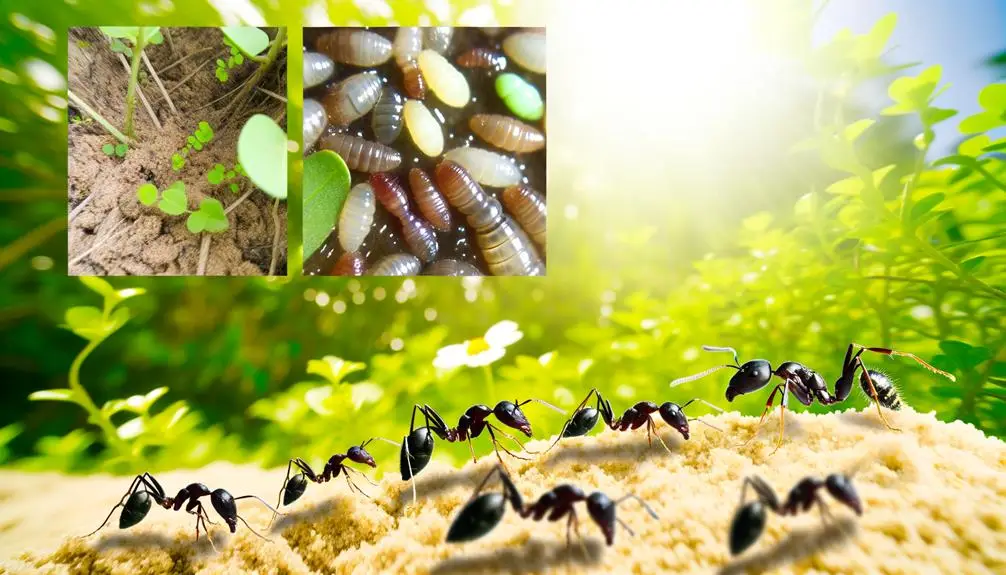
While you may not often see them, the life cycle and reproduction of crazy ants are fascinating and complex. Crazy ants, scientifically known as Paratrechina longicornis, exhibit a unique breeding process that varies with environmental conditions. In warmer climates, they can produce sexual forms year-round, ensuring a continuous cycle of reproduction. During specific months, usually warm and rainy, winged males and females, known as alates, take flight for mating.
Mating typically occurs outside the nest, where males gather near entrances, waiting for females to emerge. After mating, the males die, while the fertilized queens shed their wings and search for suitable nesting sites. Once a queen finds a location, she lays her eggs, which hatch into larvae. The queen cares for the brood, ensuring their development into adult ants.
The worker ants, which are sterile females, play a crucial role in the colony. They forage for food, care for the queen and her offspring, and maintain the nest. Over time, a single queen can produce thousands of workers, leading to colonies that can range from moderate to very populous.
The life cycle of crazy ants emphasizes their adaptability to various environments, contributing to their widespread presence in South Florida homes. Understanding this cycle helps in managing infestations effectively, as recognizing the timing of reproduction can aid in implementing control strategies at the right moments. By being informed about their reproductive habits, you can better prepare for potential encounters with these resilient pests.
Economic Impacts of Ants
Ant infestations can lead to significant economic impacts, particularly in urban and agricultural settings. For homeowners, these pests can disrupt daily life and create health concerns, especially if they invade kitchens or food storage areas. The presence of ants might deter potential buyers, leading to decreased property values. Additionally, the cost of pest control services can add up, particularly for persistent infestations requiring ongoing management.
In agricultural contexts, the economic effects of ants are even more pronounced. They can interfere with crop production by damaging seeds and promoting harmful pests like aphids and mealybugs, which they tend for honeydew. This symbiotic relationship can lead to reduced crop yields and increased costs for farmers, who must invest in both pest control and potential crop losses. Moreover, ants can disrupt local ecosystems, potentially harming beneficial insect populations that contribute to pollination and pest management.
Commercial settings, such as restaurants and food production facilities, face their own economic challenges due to ant infestations. An invasion can lead to health code violations, costly fines, and damage to reputation. Customers may choose to avoid businesses known for pest issues, leading to a decline in sales.
Pest Control Strategies
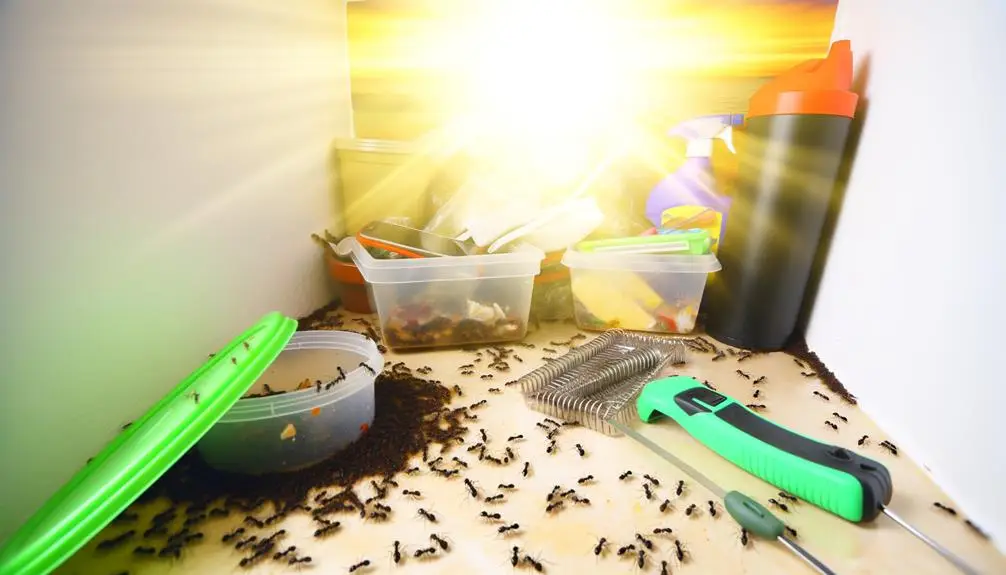
Effective pest control strategies are vital for managing ant infestations, especially given their potential economic impact in homes and businesses. To combat these pesky invaders, you’ll want to adopt a multifaceted approach that combines prevention, monitoring, and treatment methods.
First, start by eliminating food sources that attract ants. Keep your kitchen clean by storing food in airtight containers and promptly cleaning up crumbs and spills. Regularly taking out the trash and sealing garbage bins can also deter ants from entering your home.
Next, focus on exclusion techniques. Inspect your home for potential entry points, such as cracks in walls, gaps around windows and doors, and holes in screens. Sealing these openings with caulk or weather stripping can significantly reduce the likelihood of ants finding their way inside.
When monitoring for ant activity, pay attention to trails and nesting sites. Identifying where ants are entering your home can help you pinpoint areas that need treatment. You can use commercial insecticidal baits, which attract ants and are carried back to the colony, effectively killing the queen and other colony members over time. For severe infestations, consider contacting a professional pest control service.
Remember to follow label instructions carefully when using any chemical products, ensuring safety for your family and pets. By implementing these strategies, you can effectively manage ant populations and minimize their impact on your property.
Non-Chemical Management Techniques
Managing ant infestations without chemicals can be both practical and effective. One of the most important steps you can take is to eliminate food sources that attract ants. Keep your kitchen clean by promptly cleaning up spills, crumbs, and pet food. Store food in airtight containers and regularly empty your trash bins.
Next, consider sealing entry points. Inspect your home for gaps and cracks around windows, doors, and foundations. You can use caulk to seal these openings, which will help prevent ants from entering. Similarly, weather-stripping can be applied to doors to make it more difficult for them to find their way inside.
You should also look into natural deterrents. Vinegar and water solutions can be sprayed in areas where ants are spotted. The strong smell disrupts their scent trails, making it less likely they’ll return. Additionally, diatomaceous earth is a non-toxic powder that can be sprinkled in ant-prone areas. It works by damaging their exoskeletons and dehydrating them.
Lastly, if you can identify nesting sites around your property, remove nests when possible. This might include cleaning up debris, such as piles of leaves or rotting wood, where nests are often found. Regular yard maintenance can go a long way in minimizing ant habitats.
Chemical Control Options
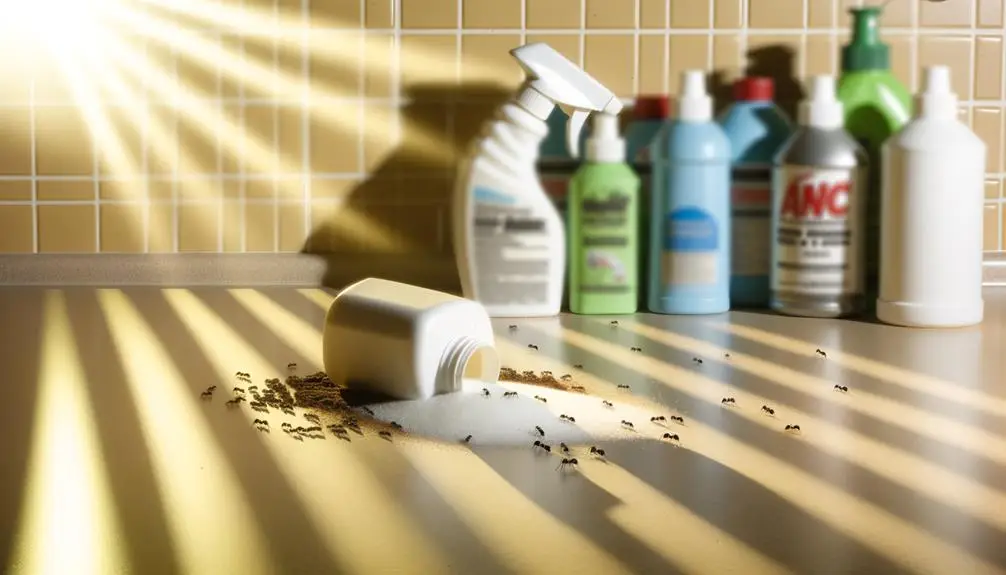
When it comes to tackling ant infestations, chemical control options can provide a swift and direct solution. You might consider using baits, dusts, and sprays specifically designed for ant control. Baits are particularly effective because they attract ants to a poison that they then carry back to their colony. This method targets the entire colony, including the queen, which is crucial for long-term success. Look for slow-acting baits that allow time for the foraging ants to transport the poison before it takes effect.
In more severe infestations, dusts can be applied in wall voids, cracks, and crevices where ants may be nesting. Insecticidal sprays can also be effective for immediate results, but they often do not eliminate the entire colony. Therefore, it’s wise to combine methods for better efficacy.
Always follow the manufacturer’s instructions when applying any chemical treatments. Safety precautions are vital, especially in homes with children or pets. Ensure that treated areas are inaccessible until dry, and ventilate the space if necessary.
Regular monitoring is important after treatment. Keep an eye out for any signs of returning ant activity, and if the problem persists, consider consulting a professional pest control service. With the right chemical control options and careful application, you can effectively manage ant infestations and restore peace to your home.
Preventing Indoor Infestations
Preventing indoor infestations starts with maintaining a clean and organized environment. Regularly cleaning your home can significantly reduce the chances of attracting black ants. Make it a habit to sweep and vacuum floors, wipe down counters, and clean up spills immediately. Don’t forget to remove any food debris, as even tiny crumbs can entice these pests.
Proper food storage is crucial. Use airtight containers for dry goods, and keep perishable items in the refrigerator. This not only makes your kitchen less appealing but also helps maintain food quality. Additionally, take out the trash regularly and ensure it’s sealed tightly. This simple step can deter ants from establishing a presence in your home.
Inspect your home for entry points. Seal cracks and gaps around windows, doors, and foundations with caulk or weather stripping. Ants are small and can exploit even the tiniest openings. If you have any outdoor plants or vegetation close to your home, keep them trimmed back. This helps prevent ants from using them as bridges to enter your living space.
Be mindful of moisture, as many ants are attracted to damp areas. Fix any leaks and ensure proper drainage around your home. Regularly check areas like basements and attics for signs of moisture.
Importance of Professional Help
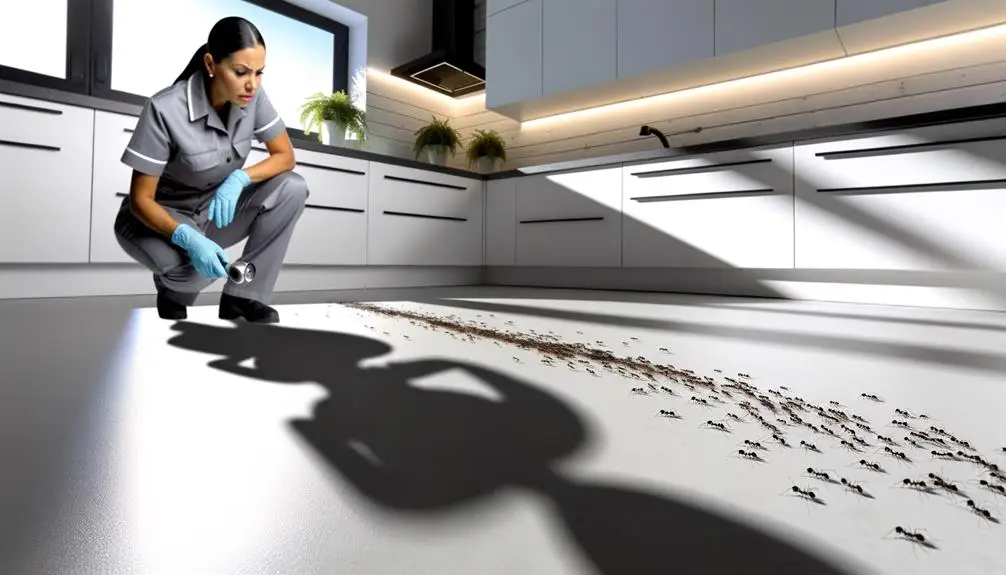
While maintaining a clean home can significantly reduce the risk of ant infestations, sometimes the problem requires more than just DIY efforts. When you notice a persistent presence of black ants despite your best cleaning efforts, it’s time to consider professional help. Pest control experts bring specialized knowledge and tools that can effectively address ant infestations.
Professional pest control services can accurately identify the species of ant invading your home, which is crucial for selecting the right treatment. Different ant species exhibit varying behaviors and nesting habits, making targeted interventions necessary. For example, crazy ants and white-footed ants may require distinct management strategies.
Additionally, pest control professionals use advanced methods and products that are often not available to the general public. They can apply treatments in hard-to-reach areas, ensuring that nests are effectively targeted. This thorough approach not only eliminates visible ants but also disrupts their colonies, preventing future infestations.
Moreover, pest control experts can offer valuable advice on long-term prevention strategies. They can help you identify potential entry points and recommend modifications to your home environment that discourage ants from returning.
Frequently Asked Questions
What Attracts Ants to Homes in South Florida?
Did you know that approximately 30% of households in South Florida report ant infestations? You’ll find that ants are attracted to homes for food, moisture, and shelter. They’re drawn to crumbs, sugary substances, and pet food, which you might leave out. Additionally, areas with standing water can be appealing. To prevent these pests, it’s crucial to keep your home clean, seal food tightly, and eliminate any water sources around your property.
Can Ants Cause Damage to My Home?
Ants generally don’t cause significant damage to your home, but they can become a nuisance. They’re often attracted to food sources, leading them into kitchens and pantries. While most species won’t compromise structural integrity, some, like carpenter ants, can damage wood. Additionally, their presence might indicate moisture issues or other underlying problems. To prevent infestations, keep food sealed and maintain cleanliness. If you notice a large number, consider consulting a pest control professional.
How Can I Tell if I Have an Ant Infestation?
If you’re dealing with an ant infestation, it can feel like an army invading your home! Look for signs like trails of ants marching across countertops or floors, especially near food sources. Check for small piles of debris, which may indicate nesting sites. You might also notice increased activity around moisture-prone areas. If you spot these signs, it’s crucial to act quickly to prevent a larger invasion.
Do Ants Carry Diseases Harmful to Humans?
While ants themselves aren’t typically carriers of diseases harmful to humans, they can contaminate food and surfaces with bacteria as they forage. Some species may pick up pathogens from decaying matter or waste, potentially spreading these pathogens to your home. It’s essential to maintain cleanliness and promptly address any ant infestations to minimize exposure to possible contaminants. Regular cleaning and proper food storage can help keep your environment safe and hygienic.
Are There Seasonal Patterns in Ant Activity?
You might think ants are active year-round, but they actually show distinct seasonal patterns. In warmer months, you’ll notice increased foraging as they seek food for their colonies. During cooler periods, activity may decline significantly. This seasonal shift occurs because ants rely on temperature and food availability. When winter arrives, many species enter a dormant state, conserving energy until conditions improve, leading to a resurgence in the spring as resources become plentiful again.
Keep Your Home Ant-Free: Protect Your Space From Black Ants!
Understanding the habits of common black ants around South Florida homes is key to effective protection. By identifying species, recognizing nesting patterns, and using a combination of non-chemical and chemical solutions, you can keep these pests at bay. Proper sanitation and exclusion practices prevent infestations, but for a thorough, lasting solution, trust the professionals.
Take control of your home environment with proactive measures and expert help. Contact NaturePest Holistic Pest Control today for a comfortable, ant-free home you can enjoy year-round!

